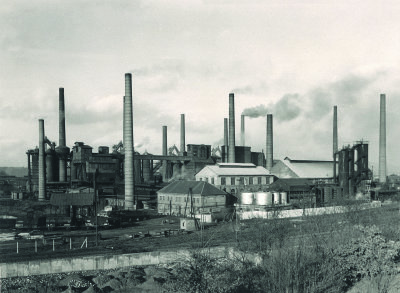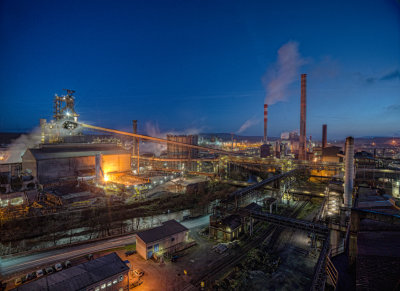Innovation & Tradition
Innovation from Tradition
From industrial revolution up into the Internet age – steel has been making things possible and driving technologies forward. Dillinger has co-authored the history of progress since 1685. Our innovative methods, optimised processes and ever more productive facilities have continuously pushed back the limits of the feasible. We pursue our aim of giving our customers the biggest possible lead with our groundbreaking products and services. A major portion of the around 2,000 grades of steel which we supply have, for example, been developed within the past ten years. And we are adjusting our process chain to "Industry 4.0" technologies in ever more sectors, to enable Dillinger to supply better solutions for you even faster and even more flexibly in the future.
On the road to the Steel Industry 4.0
The more complex the production processes and the longer the value chains, the greater the benefits of comprehensive networking of people, machines and products. For this reason, the "things and services" Internet offers, for the steel industry, in particular, unique potentials for boosting productivity, quality, flexibility and efficiency. We at Dillinger recognised this fact at a very early stage and have already created numerous preconditions for the implementation of future-orientated technologies, ranging from logistics, via production and quality assurance, up to and including maintenance. We are pursuing the road to the Steel Industry 4.0 consistently because, at the head of this movement, we put ourselves and our customers in the best possible position for successfully countering further rising cost- and competition pressures.
Some recent examples:
Dillinger heavy plate used in the world's largest offshore heavy-lift cranes: High-strength heavy plate from Dillinger is indispensable wherever the format, strength and quality of the steels used are of existential importance. In Type MTC 78000 offshore heavy-lift cranes, for example, which are among the largest of their kind in the world, with a lift capability of 2,000 tonnes. Their use for some of the world's largest heavy-lift vessels, such as the OSA Goliath, in the Gulf of Mexico, approaches the load-bearing limits of both machine and material. In addition to the out-of-the-ordinary range of properties, with yield strengths of up to 690 MPa, the unique thickness and dimensional diversity of our heavy plates gave the conclusive impulse in the decision to use these high-performance steels for the MTC 78000. Read more...
140 mm thick TM plates with national technical approval (NTA): Our advances on the materials side have now been rewarded by national technical approval. Dillinger is the only producer capable of supplying thermomechanically (TM) rolled plates in Grade S355 M/ML in thicknesses up to 140 mm. These plates provide a double benefit: on the one hand, the NTA assures safety up to 140 mm tested in accordance with state building regulations while, on the other hand, the extra thickness provides designers with new creative potentials.
Use of waste-heat for Slab Pusher Furnace 3: The production of heavy plates is extremely energy-intensive. For this reason, we constantly pursue the aim of operating our processes and facilities as efficiently as possible. One example of this is the installation of evaporators in the slab pusher furnaces, by means of which an additional annual approx. 50,000 tonnes of steam are generated. This steam is sufficient, for example, to heat 2,000 private households. The steam is fed directly into our steam system to be used for heating of buildings, plant facilities and tanks. Steam generation in this way at the same time protects the environment, since it will, in future, no longer be necessary to generate this steam by combusting fuel. The sophisticated waste-heat utilisation system installed on Slab Pusher Furnace 3 is a showcase example of active environmental protection and of maximisation of energy-efficiency.
Environmentally friendly energy generation: Innovative steel products such as wind-power installations and modern power-generating plants save six times more CO2 than their manufacture causes. This is the conclusion of a study performed by the Boston Consulting Group. At Dillinger, we make an important contribution to environmentally friendly energy generation with, for example, the delivery of some 62,000 tonnes of steel for the Westermost Rough (North Sea) and EnBW Baltic 2 (Baltic Sea) offshore wind farms, which supply more than 150,000 British and 340,000 German households, respectively, with environmentally friendly electricity. This makes it possible to save more than one million tonnes of CO2 each year.
The focus of our heavy-plate research is on application-orientated research for special customer wishes which are not included in our standard delivery program. The aim of Dillinger's researchers is to achieve the capability, by means of improved understanding of steel microstructures, and using computer-assisted models, of designing new property combinations – without time-consuming, cost-intensive operational tests. Our materials-science knowledge and modern aids, such as the scanning electron microscope (SEM), enable us to push back the limits of the possible even further.
Support for the Department of Materials Science and Engineering of the Saarland University: Here at Dillinger, our aim is to constantly improve the already high quality of our heavy steel plate even further by means of joint research work. The foundations of offshore wind-power installations and oil drilling rigs around the globe provide excellent examples of applications in which high-performance steels from Dillinger are used. The heavy steel plates utilised in these structures must assure safe operation even after many years of exposure to extreme stresses. Innumerable small adjustments are necessary in the production of such special steels in order to meet the extremely high requirements set for these foundations. It is our intention to further optimise this complicated process jointly with the Saarland University.
333 years of Dillinger
Dillinger is one of Europe's oldest companies. The challenges, the processes and the technologies have changed in the course of the centuries, but we nonetheless remain true today to our fundamental aims and values. We repeatedly set new milestones with reliability, quality and equitability:
2017 The world's thickest-ever slab: 600 mm!
2016 The new CC6 vertical continuous caster sets standards in all dimensions
2014 Founding of Steelwind Nordenham
2014 GTS Industries becomes Dillinger France
2010 The world's thickest-ever slab: 450 mm!
1998 The world's first continuous-caster for the 400 mm slab thickness, incorporating Soft Reduction
1992 Integration of the GTS Industries heavy-plate rolling-mill
1991 Founding of Europipe, jointly with Mannesmann and GTS Industries
1985 Commissioning of a 5.5 m four-high rolling-mill
1981 Founding of ROGESA (iron smelting) and ZKS (coke)
1961 Commissioning of the world's first slab continuous-caster
1948 Dillinger Hütte is a co-founder of SOLLAC
1835 The "Dillingen platemaker's gauge" becomes the recognised standard throughout Europe
1809 Germany's first joint stock corporation
1804 Rolling of the first plate at Dillingen
1685 Founding by the Marquis de Lenoncourt on instruction from Louis XIV

Innovative top-quality steel products, total orientation around our customers' needs and unceasing technological development in close cooperation with our partners form the basis of our success - as they have for more than 333 years.
© 2016 Dillinger All rights reserved.
Contact
AG der Dillinger Hüttenwerke
Werkstraße 1
66763 Dillingen/Saar
Tel.: +49 6831 47 0
Fax: +49 6831 47 2212
E-Mail: info@dillinger.biz
Imprint
| Data privacy statement
| T&C



